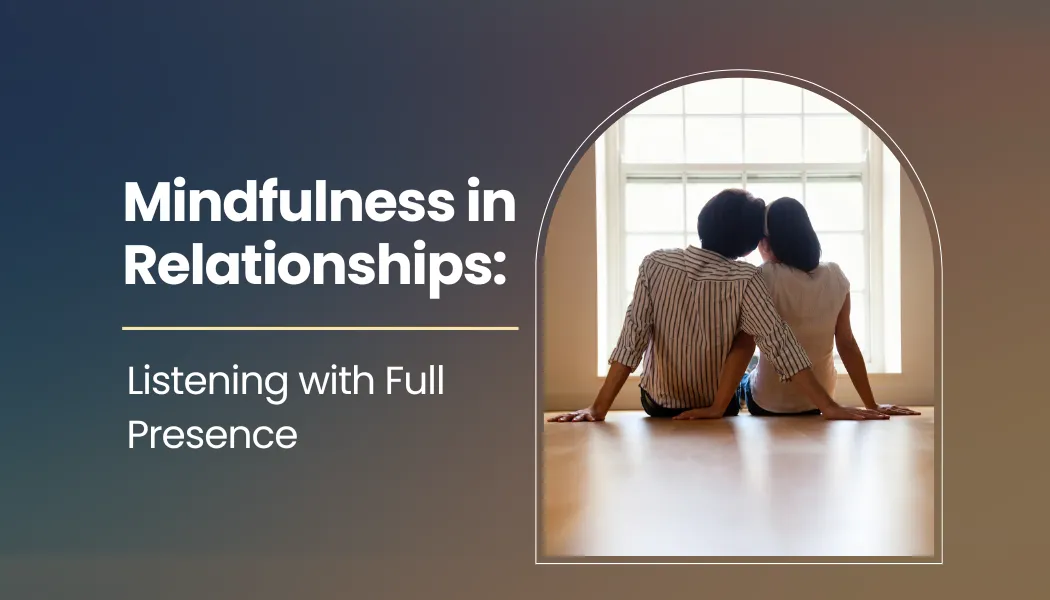Relationships are the foundation of our lives—whether with partners, family, friends, colleagues, or even casual acquaintances. At the heart of every healthy relationship lies one essential skill: listening. Not the kind of listening where we simply nod along, half-distracted by our phones or inner chatter, but the kind of deep, mindful listening that makes the other person feel seen, heard, and valued. This kind of listening is what many spiritual teachers, psychologists, and mindfulness practitioners call “listening with full presence.”
Mindful listening is more than a communication technique—it is a practice, a way of being. It allows us to slow down, soften our judgments, and step into the world of another person with openness and compassion. In a time when our attention is fragmented by constant notifications, rushing schedules, and digital noise, mindful listening can feel almost revolutionary. And yet, it is exactly what many of us crave: to be listened to without interruption, without judgment, and with genuine care.
In this article, we’ll explore what it means to practice mindful listening in relationships, why it matters, the obstacles we face, and practical steps anyone can take to listen with full presence. Along the way, we’ll weave in real-life examples, psychological insights, and mindfulness techniques that can turn conversations into opportunities for connection and healing.
Table of contents
- Why Listening Matters More Than We Think
- The Obstacles to Listening with Presence
- What Is Mindful Listening?
- The Benefits of Listening with Full Presence
- Practical Ways to Listen with Presence
- Real-Life Examples of Mindful Listening
- The Inner Work of Listening
- Overcoming Common Challenges
- Mindful Listening as a Daily Practice
- The Ripple Effect of Listening
- Final Thoughts
Why Listening Matters More Than We Think
We often assume that communication is about speaking clearly, but in truth, the greater art is in listening. Consider this:
- When a child shares a story, what they really want is not our advice but our full attention.
- When a partner vents after a long day, what they seek is not a quick fix but empathy.
- When a friend shares a personal struggle, what they long for is not judgment but safety.
Listening with presence transforms these everyday interactions into moments of genuine connection. Research in psychology shows that when people feel truly listened to, their stress levels decrease, their trust in the relationship increases, and conflicts are more easily resolved.
In fact, studies on couples’ therapy have found that the single biggest predictor of marital satisfaction is not how often couples fight but how well they feel heard and understood by each other. Similarly, in the workplace, employees who feel listened to by their managers report higher job satisfaction and commitment.
Listening, then, is not passive—it is an active gift we give to others. It is also a gift to ourselves, because when we listen deeply, we cultivate patience, empathy, and presence in our own minds.
The Obstacles to Listening with Presence
If mindful listening is so valuable, why is it so difficult to practice? The truth is, our modern lives are full of obstacles that make deep listening challenging:
- Distractions Everywhere – Phones buzzing, emails waiting, tasks piling up. Our attention is constantly being pulled in different directions.
- Inner Chatter – Even when our ears are open, our minds are often busy forming responses, judgments, or stories instead of truly listening.
- The Urge to Fix – Many of us listen with the intention to solve, correct, or give advice rather than to understand.
- Emotional Reactivity – When conversations touch on sensitive topics, we may become defensive, angry, or hurt, making it harder to stay present.
- Time Pressure – We rush through conversations without giving them the space they need.
Recognizing these obstacles is the first step. Once we see them clearly, we can begin to counteract them through mindfulness.
What Is Mindful Listening?
Mindful listening is the practice of being fully present with another person while they speak. It involves:
- Attention: Giving the speaker your undivided focus, without multitasking.
- Awareness: Noticing both the words and the emotions behind them.
- Non-judgment: Suspending criticism, assumptions, or the urge to immediately categorize what is said.
- Compassion: Approaching the speaker with empathy, even when you disagree.
- Silence: Allowing pauses, rather than rushing to fill every gap with your own words.

In mindfulness terms, listening is not about preparing your reply but about receiving the other person’s experience. As Buddhist teacher Thích Nhất Hạnh beautifully put it: “The most precious gift we can offer others is our presence. When mindfulness embraces those we love, they will bloom like flowers.”
The Benefits of Listening with Full Presence
When we practice mindful listening, something remarkable happens:
- Relationships Deepen – People feel more valued, safe, and respected. Trust naturally grows.
- Conflicts Soften – Many arguments de-escalate simply because one person feels heard.
- Empathy Expands – We begin to see beyond our own perspective into another’s reality.
- Our Own Stress Reduces – Listening mindfully grounds us, slows us down, and helps us regulate emotions.
- Clarity Emerges – With careful listening, misunderstandings are reduced, and communication becomes clearer.
Think of the last time you felt truly listened to. Perhaps a friend sat with you and gave you their complete attention. You probably walked away feeling lighter, calmer, and more connected. That is the power of presence.
Practical Ways to Listen with Presence
So, how do we bring this into our daily lives? Here are some practices:
1. Put Away Distractions
When someone speaks, silence your phone, close your laptop, or pause the TV. This signals respect and sets the stage for real listening.
2. Practice “Beginner’s Mind”
Approach the conversation as if you are hearing this story for the first time—even if you’ve heard it a hundred times. Drop assumptions and stay curious.
3. Use Your Body Language
Face the speaker, make eye contact, and nod gently. Nonverbal cues show that you are present and engaged.
4. Listen to Feelings, Not Just Words
Often, what someone says is only the surface. Listen for tone, pace, and pauses—they reveal emotions that may not be spoken outright.
5. Pause Before Responding
Instead of jumping in, take a breath. This moment of pause helps you respond with thoughtfulness rather than reactivity.
6. Reflect Back What You Hear
You might say, “It sounds like you’re really frustrated,” or “I hear that this situation is painful for you.” Reflection shows understanding.
7. Resist the Urge to Fix
Sometimes the best response is silence or a simple, “I’m here with you.” Advice can come later—first, listen.
8. Cultivate Patience
Let conversations unfold without rushing. Allow pauses. Silence is not empty; it gives space for deeper sharing.
Real-Life Examples of Mindful Listening
- Parenting: A teenager storms home upset about school. Instead of lecturing, the parent listens silently, nodding, and validating feelings. The child softens and opens up more.
- Partnerships: A couple argues over chores. One partner practices mindful listening—reflecting, “I hear that you feel unsupported.” The tension diffuses, and they find a solution together.
- Workplace: A manager listens attentively to an employee’s concerns without checking emails. The employee feels valued and motivated.
These scenarios show how presence can transform ordinary conversations into opportunities for trust and growth.
The Inner Work of Listening
Mindful listening is not just about how we treat others—it’s also about inner work. To listen deeply, we must cultivate awareness of our own minds:

- Notice Your Reactions: Do certain words trigger defensiveness? Simply observe without acting on it.
- Anchor in the Breath: Use the breath to stay grounded during difficult conversations.
- Develop Compassion: Remind yourself that the speaker, like you, has struggles and hopes.
- Let Go of Ego: The conversation is not about proving yourself right but about understanding another human being.
By strengthening these inner qualities, we become better listeners naturally.
Overcoming Common Challenges
Even with practice, challenges will arise. Here are some common ones and how to handle them:
- When You’re Distracted: Gently notice your wandering mind and bring it back, just as you would in meditation.
- When You Disagree Strongly: Focus on listening first, rather than forming counterarguments. Understanding does not mean agreeing.
- When Conversations Are Long: Take breaks if needed, but let the speaker know you care: “I want to give you my full attention, can we continue after dinner?”
- When Emotions Run High: Slow the pace with deep breaths. Sometimes silence is the most compassionate response.
Mindful Listening as a Daily Practice
Mindful listening is not a one-time skill but a lifelong practice. Here are ways to integrate it daily:
- Dedicate at least one conversation a day where you practice full presence.
- Set family or team agreements around “device-free” listening.
- Journal about moments when you felt listened to—and when you didn’t. Reflect on the difference.
- Practice meditation that focuses on compassion and presence—it strengthens your listening muscles.
The Ripple Effect of Listening
When we listen with presence, the impact ripples outward:
- Families become more harmonious.
- Friendships deepen.
- Workplaces become more collaborative.
- Communities grow more compassionate.
Imagine if schools taught children not only how to speak but also how to listen. Imagine political debates where opponents truly tried to hear each other. Imagine a world where listening was as valued as speaking.
It may sound idealistic, but change begins in small acts. Each time you pause, breathe, and listen with presence, you contribute to a more connected world.
Final Thoughts
Listening with full presence is not always easy, but it is always worth it. It requires patience, humility, and mindfulness. But the reward is profound: deeper relationships, greater understanding, and a sense of shared humanity.
In our noisy, distracted world, mindful listening is a quiet revolution. It reminds us that at the heart of every relationship is not just the exchange of words, but the exchange of presence. And when we give that presence fully, we create relationships that heal, nurture, and endure.
